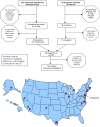Implementing the community health worker model within diabetes management: challenges and lessons learned from programs across the United States
- PMID: 18832287
- PMCID: PMC5920550
- DOI: 10.1177/0145721708323643
Implementing the community health worker model within diabetes management: challenges and lessons learned from programs across the United States
Abstract
Purpose: The purpose of this qualitative study was to examine methods of implementation of the community health worker (CHW) model within diabetes programs, as well as related challenges and lessons learned.
Methods: Semi-structured interviews were conducted with program managers. Four databases (PubMed, CINAHL, ISI Web of Knowledge, PsycInfo), the CDC's 1998 directory of CHW programs, and Google Search Engine were used to identify CHW programs. Criteria for inclusion were: DM program; used CHW strategy; occurred in United States. Two independent reviewers performed content analyses to identify major themes and findings. Sixteen programs were assessed, all but 3 focused on minority populations. Most CHWs were recruited informally; 6 programs required CHWs to have diabetes.
Results: CHW roles and responsibilities varied across programs; educator was the most commonly identified role. Training also varied in terms of both content and intensity. All programs gave CHWs remuneration for their work. Common challenges included difficulties with CHW retention, intervention fidelity and issues related to sustainability. Cultural and gender issues also emerged. Examples of lessons learned included the need for community buy-in and the need to anticipate nondiabetes related issues.
Conclusions: Lessons learned from these programs may be useful to others as they apply the CHW model to diabetes management within their own communities. Further research is needed to elucidate the specific features of this model necessary to positively impact health outcomes.
Figures
References
-
- Harris MI, Flegal KM, Cowie CC, et al. Prevalence of diabetes, impaired fasting glucose, and impaired glucose tolerance in U.S. adults. The Third National Health and Nutrition Examination Survey, 1988–1994. Diabetes Care. 1998 Apr;21(4):518–524. - PubMed
-
- Harris MI, Klein R, Cowie CC, Rowland M, Byrd-Holt DD. Is the risk of diabetic retinopathy greater in non-Hispanic blacks and Mexican Americans than in non-Hispanic whites with type 2 diabetes? A U.S. population study. Diabetes Care. 1998 Aug;21(8):1230–1235. - PubMed
-
- Young BA, Maynard C, Boyko EJ. Racial differences in diabetic nephropathy, cardiovascular disease, and mortality in a national population of veterans. Diabetes Care. 2003 Aug;26(8):2392–2399. - PubMed
-
- Earp JA, Viadro CI, Vincus AA, et al. Lay health advisors: a strategy for getting the word out about breast cancer. Health Educ Behav. 1997 Aug;24(4):432–451. - PubMed
-
- Eng E. Emerging theories in Health Promotion. 2002.
Publication types
MeSH terms
Grants and funding
LinkOut - more resources
Full Text Sources
Medical



